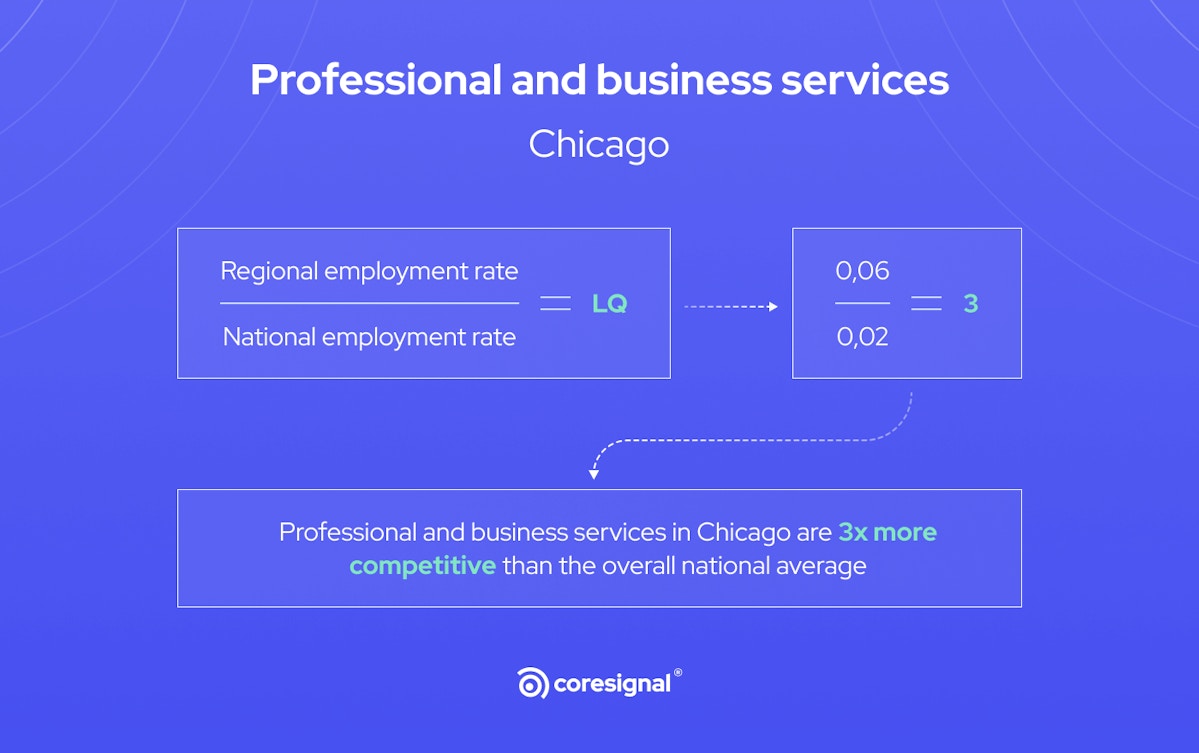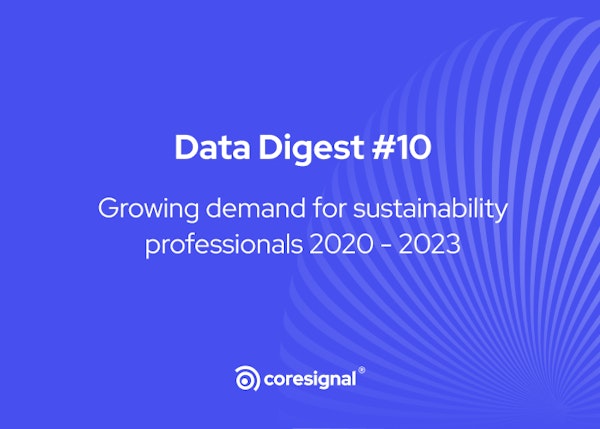Professional network data
Leverage our top B2B datasets
Job posting data
Get access to hundreds of millions of jobs
Employee review data
Get data for employee sentiment analysis
Clean dataNEW
Enhanced professional network data
Employee data
Get data on global talent at scale
Funding data
Discover and analyze funding deals
Firmographic data
Unlock a 360° view of millions of companies
Technographic data
Analyze companies’ tech stacks
BY INDUSTRY
MOST POPULAR USE CASES
Investment
Leveraging web data for informed investing
HR tech
Building or enhancing data-driven HR tech
Sales
Supercharging your lead generation engine
Marketing
Transforming marketing with web data
Market research
Conducting comprehensive market research
Lead enrichment
Use Coresignal’s data for enrichment
Talent analytics
Analyze talent from multiple perspectives
Talent sourcing
Comprehensive talent data for recruitment
Investment analysis
Source deals, evaluate risk and much more
Target market analysis
Build a complete view of the market
Competitive analysis
Identify and analyze competitors
B2B Intent data
Lesser-known ways to find intent signals
BY INDUSTRY
MOST POPULAR USE CASES
Investment
Leveraging web data for informed investing
HR tech
Building or enhancing data-driven HR tech
Sales
Supercharging your lead generation engine
Marketing
Transforming marketing with web data
Market research
Conducting comprehensive market research


Andrius Ziuznys
January 7, 2022
What is the location quotient?
The location quotient (LQ) is a mathematical formula or a method used to determine the concentration of employment in a regional industry in relation to national metrics.
It allows understanding the strengths and weaknesses of a specific region and what industries tend to prosper in the particular economy.
Let's take Europe as an example. Let's say that Europe is the national level of comparison and all the countries are regions. If you asked someone in what region (in this case, country) the automotive industry is the strongest, most people would probably name Germany. Even though you can manufacture cars in many larger European countries, Germany comes to mind, because they have established their name as a reliable car manufacturer and the location quotient plays a role in that which will be explained later on.
However, if you take the fashion industry, Germany most likely will leave your mind, and instead, you’ll head towards Italy.
In other words, each region has its own advantages, and the location quotient allows you to benefit from them.
As a result, you would know that investing in cars is more valuable in Germany than Italy, and in the case of investing in fashion, Italy is the better choice.
Regional and national metrics
The math behind the location quotient method is based on the regional and national metrics. Let's discuss them in greater detail.
Regional economy vs national economy
In order to calculate the location quotient, you first need to find and compare regional and national economies and apply the formula to arrive at a conclusion.
Regional and national numbers are the fundamental factors upon which the calculations are based.
We will discuss later about finding the required data and doing the calculations.
Regional employment and national employment
Comparing the employment concentration allows you to determine the accuracy of the location quotient. Just because a local industry has a high LQ, that doesn’t necessarily mean that loss in employment in that industry would shake the local economy’s status.
For example, industry X could have an LQ of 8, whereas industry Y and Z in the same region could have an LQ of 3 and 4, respectively. However, let's say that industry X has 600 employees, whereas industry Y has 50 and industry Z has 80 employees.
As a result, even though location quotients of 3 and 4 are high, loss in employment in industries Y and Z would not break the overall success of the region, because they have a small number of employees compared to industry X. However, if industry X were to lose a significant number of workers, then the local economy would be in far greater trouble than if industries Y and Z lost a significant number of employees.
Therefore, it's important to account for the number of employees in order to get accurate and applicable location quotient data.

Import and export industries
The location quotient helps with identifying industries with a competitive advantage or lack thereof. In general, industries attributed with high location quotient percentages are usually considered export industries. On the other hand, industries with a low location quotient percentage are import industries.
Let's delve into the two types of industries in greater detail.
Import industries
Import industries are the ones whose economic growth does not meet the region's demand. In other words, those industries need to import products or services from other regions in order to fulfill their residents' demands. This type of industry is circulating local dollars and supporting higher impact industries by buying their products.
Lower LQ industries are usually considered import industries.
Export industries
These types of industries, on the other hand, are the ones that produce more than required and are able to export their goods for more profit. If the residents of the region do not consume all of the products of the industry, export becomes available to the regions that do not produce enough for the residents to consume.
For instance, Germany produces a lot more cars than its people need. As a result, they can export their product to other countries that have a demand for cars and make more profit than the area average.
Higher LQ industries are often considered export industries.
How to acquire data for location quotient calculations?
Acquiring data to calculate location quotients can be done in two ways: collecting it on your own or purchasing from a data provider. Let's compare the pros and cons of each option.
Collecting the data
If you choose to gather the information on your own, the only positive outcome is that you will likely save money. However, it's going to take quite a lot of time, depending on how many regions and industries you want to compare.
You can access the data required for location quotient calculations online through various federal and state government websites. For instance, the U.S. Bureau of Labor Statistics provides the average annual employment information of major industries.
However, as mentioned before, the scope of your analysis is a significant factor. Gathering data for extensive analyses can prove to be quite time-consuming and result in lesser cost-efficiency than spending money on a ready-made dataset and saving time.
Relying on a data provider
The more convenient way of gathering data is by purchasing a dataset from a data provider, such as Coresignal. Even though the data could be costly, depending on your needs, it's still more effective in the long run.
For the location quotient case specifically, firmographic data is what you should opt for. Fresh and continuously updated data on headcount and annual revenue will help you find the industries quickly and easily. You get to see an extremely detailed overview of separate companies and make data-backed decisions that eliminate any guesswork. You can even filter relevant industries by unique identifiers to save more time.
All in all, the use of public web data to come up with solutions has proven time and time again that the benefits supersede the costs.
How to calculate the location quotient?
Now that you know what is required to calculate the location quotient, it's time to delve into the technical side of it.
Calculating the location quotient is pretty simple: you just need to divide the regional employment rate by the national employment rate. For example, let's say that the professional and business services industry accounted for 6% of all jobs in Chicago and 2% of all national jobs in general. That means in Chicago, the professional and business services location quotient would be 0,06 / 0,02 = 3.
In conclusion, professional and business services in Chicago are 3x more concentrated in the local economy than the overall national average.

Industry example
Leisure and hospitality industry
Let's say that the leisure and hospitality industry in Orlando has an LQ of 13. The industry employs 1300 people in total and is the leading industry in the region.
However, there are more industries in Orlando, such as advanced manufacturing, aerospace, biotech, and more. Let's assume that advanced manufacturing has an LQ of 6 (800 employees), aerospace - 4 (400 employees), and biotech - 5 (550 employees).
Even though the leisure industry is the most prominent, it's worth noting that the other industries also have a significant location quotient. Furthermore, the employee count is relatively high as well. If the employee count of the other industries were fewer than 50, the loss of workforce in those industries would not affect the overall Orlando economy much. However, when dealing with large numbers and decent location quotients, the loss of employment in any of the aforementioned industries will affect the regional economy numbers.
Also, the average hourly income plays a significant role in determining the local economy status. The higher the income, the more devastating the effect employment loss has on the overall average. Let's say the leisure industry earns $40/h. Losing employees would result in a significant change in the entire regional economy. On the other hand, hiring more employees would result in more profit and improve the industry's stance even further.
Accounting for the positive or negative change is key to accurately depicting the overall economic picture.
All in all, when analyzing a region's economic base, it's not enough to simply look at the top industry and make all decisions based on that. It's necessary to look into the firmographic information of the other industries and try to build an accurate and well-informed model.

The importance of location quotient
Location quotient allows you to see which communities prosper in a particular industry. It promotes local or regional specialization. Imagine a community with a high LQ. They usually have their own business cluster in which they cooperate, support, and benefit from each other.
Identifying such a cluster might give you the incentive to expand to such a location if you're a business owner, or invest in the cluster if you're an investor.
In general, the location quotient has the potential to assist your financial activities and business affairs significantly.
Location quotient plays a significant role in the following fields:
- Discovering unique local industries;
- Recognizing export and import industries;
- Identifying endangered export industries.
Discovering unique local industries
Identifying unique local industries allows you to see what makes a specific economy distinctive. Location quotient provides you with information about a particular industry that stands out in a region.
If the industry has higher employment rates than the overall national average, it means it has a higher LQ and has a competitive advantage in that specific regional economy.
Recognizing export and import industries
Differentiating between export and import industries is important because you can make better decisions regarding what industry in what region is worth your attention as an investor or business owner. The region's export industries have a higher LQ and they produce more goods and services than the local economy requires; therefore indicating a healthier economy and allowing for export to different regions. In other words, the aforementioned industries are more successful and make more profit than import industries.
On the other hand, you might notice an import industry that has the potential to grow substantially if they had more resources. You could take a chance and turn the import industry around.
Identifying endangered export industries
One of the most important parts of the export industry aspect is knowing whether that industry is able to sustain its pace. It requires more attention and analysis, but in the long run, it's worth putting in the time and effort in order to avoid such industries altogether or help them keep their place.

The limitations of location quotient
With all the benefits that LQ has to offer, there are certain caveats to it. Perhaps the most significant limitation is that you cannot accurately measure the actual productivity of the employees.
For instance, the commercial bakeries industry in Florida might require fewer workers to meet the local demand than the national average. Also, it's important to remember that economies are continuously changing and the pace at which local and national metrics change is not always the same.
Conclusion
To conclude, location quotient plays a significant role in identifying unique industries within a region. You can discover the region's high LQ industries based on employment data. You can find more successful businesses, track economic activity, compare regional jobs to jobs nationally and arrive at insightful conclusions.
LQ helps reveal industries that perform well from the workforce-oriented perspective. The location quotient approach allows you to find flourishing industries and, therefore, enhance your business decisions. You can see the economy's health and discover high LQ signals to make better decisions.
Don’t miss a thing
Subscribe to our monthly newsletter to learn how you can grow your business with public web data.
By providing your email address you agree to receive newsletters from Coresignal. For more information about your data processing, please take a look at our Privacy Policy.

Related articles

Sales & Marketing
10 Most Reliable B2C and B2B Lead Generation Databases
Not all lead databases are created equal. Some are better than others, and knowing how to pick the right one is key. A superior...
Mindaugas Jancis
April 23, 2024

Sales & Marketing
It’s a (Data) Match! Data Matching as a Business Value
With the amount of business data growing, more and more options to categorize it appear, resulting in many datasets....
Mindaugas Jancis
April 9, 2024

Data Analysis
Growing demand for sustainability professionals 2020–2023
Original research about the changes in demand for sustainability specialists throughout 2020–2023....
Coresignal
March 29, 2024